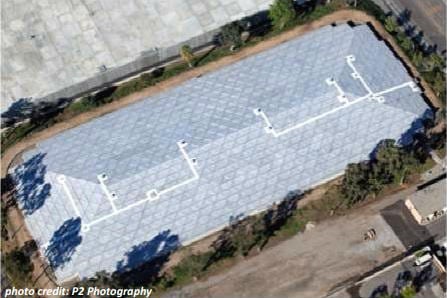Built in 1927 and upgraded in 1955, the Linden Reservoir had served well but was requiring more caretaking than in the past. John Farley, interim principal engineer at the Riverside (Calif.) Public Utilities Department compared the 61-million-L (16-million-gal) reservoir to an “elderly gentleman.” While it was serviceable and
 trustworthy, he explained, its roof needed a little more selfsufficiency, especially if it were to survive a major earthquake.
trustworthy, he explained, its roof needed a little more selfsufficiency, especially if it were to survive a major earthquake.
As one of two major waterstorage reservoirs forming the hub of Riverside’s water distribution system, the Linden Reservoir capacity was increased from 45,420 m3 (12 million gal) to 60,560 m3 (16 million gal) in 1955. At the time, a steel roof fashioned from corrugated metal cladding supported by concrete columns and a steel frame was added. Throughout the years, the roof has suffered from significant corrosion and other maintenance challenges.
More recently in 1984, the reservoir underwent a major structural overhaul of its concrete lining, but the public utilities department had grown concerned about the age and condition of the reservoir’s roof; particularly, the roof’s ability to withstand a major seismic event. “On the whole, the old roof had performed well, but we started having more and more maintenance challenges, particularly with the cladding pulling away and extensive corrosion of the steel frame,” Farley said. “We had to continually inspect the roof and repair breaches to prevent contamination and keep foreign objects out.” Ongoing maintenance costs for the roof became excessive. So the public utilities department explored replacement options and hired engineering firm URS Corp. (San Francisco) to evaluate options based on four primary requirements.
The roof needed to be long lasting, durable, and secure to keep out debris and other unwanted objects.
- The roof needed to be low maintenance. Riverside was looking for a design featuring few components that would need adjustment, repair, or replacement.
- The roof needed to sustain high seismic loads because of the region’s vulnerability to earthquakes.
- Construction had to be minimally intrusive and preserve the structural integrity of the existing reservoir — an approximately 61-m (200-ft) by 152-m (500-ft) concrete-lined earthen-embankment structure.
“Since the Linden Reservoir is an old structure, we had to make sure alterations wouldn’t damage the existing reservoir floor,” said Miko Aivazian, the URS project manager. “We’ve seen enough of these situations over the years and have sufficient expertise and data on which to base our recommendations.”
Aivazian and his team assessed 11 different roof design options such as wood, welded steel, aluminum, and even a floating membrane system. They recommended a low-profile prefabricated aluminum roof supported by stainless steel columns anchored to new pedestals in the reservoir floor. Canyon Springs Enterprises dba RSH Construction Services (Hemet, California) was awarded the project and subcontracted the roof design and manufacturing to CST Covers (Conroe, Texas).
CST’s aluminum covers are designed to conform to any shape of basin or underground storage tank, a versatility that makes them seismically resilient, which is an important quality given Riverside’s proximity to the San Andreas, San Jacinto, and Elsinore faults.
“From an engineering standpoint, one of the advantages of the CST aluminum roof is its lightweight construction,” Aivazian said. “In the event of an earthquake, the roof must be able to expand and move independently from the rest of the structure. An aluminum roof introduces smaller seismic loads into the existing structure and walls.”
The roof installation included a complex but critical support system of concrete pedestals and four seismic walls along the perimeter.
“The roof is anchored to a wall, which runs around the perimeter of the reservoir. We wanted to isolate seismic forces at four distinct locations around the reservoir so the roof supports wouldn’t have to absorb any seismic load. To achieve this, we had four [6-m] 20-ft sections of the perimeter wall removed and replaced those sections with a new anchoring system to transfer roof diaphragm seismic forces into the walls,” explained Matt Huckaby, URS project engineer.
When placing the 56 roof column supports, engineering and construction teams respected the existing reservoir structure. The existing columns supporting the old roof didn’t match the pattern required for the new aluminum roof, so crews cut the existing columns all the way to the base and preserved the existing pedestals, eliminating additional cuts to the floor slab, Aivazian said.
The roof’s custom design and modular construction led to an efficient installation. Pieces were shipped, labeled, and assembled at the job site. Lighter weight materials equated to less manpower and machinery needed to lift the pieces into place. Crews transformed the roof from an aging and corroded steel structure to a sleek, low-profile aluminum structure in just 4 months.
“The new aluminum roof along with the structural modifications to the reservoir will extend the life of the structure over 50 years,” said John Delaney, Vice President of Sales at the CST Covers.
The new roof cost little to install and will have easy long-term maintenance. Unlike other building materials, aluminum isn’t susceptible to damage from moisture, and unlike steel, it doesn’t rust and doesn’t have to be painted. The aluminum roof also is recyclable after its useful life. The low profile also enhanced the reservoir’s aesthetic appeal, Farley said.
“Driving by, you can’t really tell it’s a reservoir,” Farley said. “What you see is basically a landscaped embankment rising up from street level, and the new roof is essentially disguised in the background.”
“I credit the success of this project to the great teamwork between Riverside, the URS engineering team, and the contractor and subcontractors,” Farley added.
Benefits of CST’s Aluminum Reservoir Covers:
- Corrosion Resistance: Aluminum is inherently corrosion resistant compared to other materials. It will last the lifetime of the structure and will not need to be painted or repainted for protection from the elements.
- Low Lifetime Maintenance Cost: With no need to maintain a protective finish to prevent corrosion over time, there are little-to-no maintenance costs associated with an aluminum dome.
- Clear-Span Capability: Aluminum’s lightweight characteristics allow for larger clear-span cover capability than structures utilizing steel, concrete and other materials.
- Fast & Low-Cost Construction: Creative design and lightweight components provide for installation in 1/3 the time it takes to install other cover systems. Less time, labor and equipment needs combine for a low total cost of installation.
- Design Flexibility: Aluminum’s excellent strength-to-weight ratios and creative component designs yield covers and structures that cannot be achieved with other materials.
- Aluminum is a “Green Material”: Not only are aluminum cover systems recyclable after their service life, but more than 50% of the aluminum used in the cover systems is made from recycled aluminum.
Contact Information:
CST Industries, Inc.
844-44-TANKS
sales@cstindustries.com

